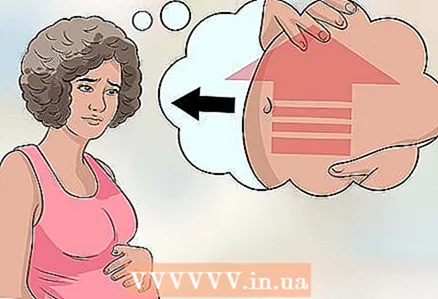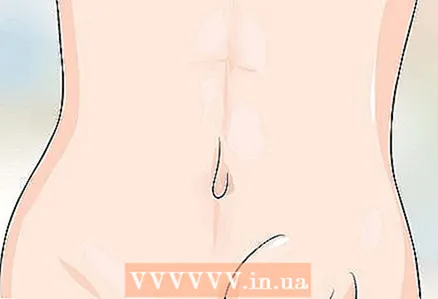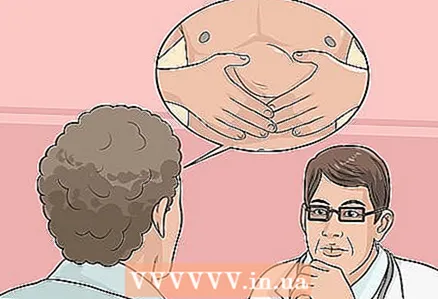
Content
- Steps
- Part 1 of 4: Symptoms
- Part 2 of 4: Risk Factors
- Part 3 of 4: Determining the type of hernia
- Part 4 of 4: Treating a hernia
- Tips
- Warnings
Each organ of the human body is located in a corresponding cavity. However, for a number of reasons, this or that organ can leave the limits of its cavity, which is why a hernia is formed. As a rule, the hernia is not life-threatening and sometimes goes away on its own. Most often, a hernia occurs in the abdomen (between the chest and thighs), with 75–80% of cases occurring in the groin area. The likelihood of hernia formation increases with age. With age, the danger of an operation to eliminate a hernia also increases. There are several types of hernia, and each of them requires appropriate treatment, so it is important to learn how to recognize a hernia and determine its type.
Attention:the information in this article is for informational purposes only. Before using any methods, consult your doctor.
Steps
Part 1 of 4: Symptoms
 1 Assess your risk factors. Although anyone can have a hernia, there are certain risk factors that make it more likely to occur. These can be both chronic diseases and temporary causes - for example, a severe cough. Risk factors for hernia include the following:
1 Assess your risk factors. Although anyone can have a hernia, there are certain risk factors that make it more likely to occur. These can be both chronic diseases and temporary causes - for example, a severe cough. Risk factors for hernia include the following: - increased pressure in the abdomen;
- cough;
- lifting weights;
- constipation;
- pregnancy;
- obesity;
- elderly age;
- smoking;
- taking steroids.
 2 Pay attention to possible bulges. A hernia is a defect in the muscular membrane of an internal organ. As a result, the organ penetrates into the hole in the muscular membrane, which leads to a hernia. When an organ enters through a breach, a ridge or bulge forms under the skin. Often, the hernia gets bigger when you are standing or straining. This bulge can appear in different places, depending on the type of hernia. Hernia types are divided according to location and cause.
2 Pay attention to possible bulges. A hernia is a defect in the muscular membrane of an internal organ. As a result, the organ penetrates into the hole in the muscular membrane, which leads to a hernia. When an organ enters through a breach, a ridge or bulge forms under the skin. Often, the hernia gets bigger when you are standing or straining. This bulge can appear in different places, depending on the type of hernia. Hernia types are divided according to location and cause. - An inguinal hernia occurs in the groin area (between the pelvic bone and the perineum).
- An umbilical hernia is observed near the navel.
- A femoral hernia appears on the inner sides of the thighs.
- A postoperative hernia is associated with a weakening of the muscle wall as a result of a surgical operation.
- Diaphragmatic, or hiatal, hernia is caused by congenital defects of the diaphragm.
 3 Pay attention to vomiting. If the hernia affects the intestines, it can make it difficult or even block the passage of food through the digestive system. This can raise food masses and cause nausea and vomiting.A partial blockage of the intestine may be accompanied by only mild symptoms, such as nausea without vomiting or poor appetite.
3 Pay attention to vomiting. If the hernia affects the intestines, it can make it difficult or even block the passage of food through the digestive system. This can raise food masses and cause nausea and vomiting.A partial blockage of the intestine may be accompanied by only mild symptoms, such as nausea without vomiting or poor appetite.  4 Pay attention to constipation. An inguinal or femoral hernia may be accompanied by constipation. Constipation is essentially the opposite of vomiting. Blocking feces can lead to constipation, in which stool does not leave the intestine, but remains in it. Needless to say, immediate surgery is required in this case.
4 Pay attention to constipation. An inguinal or femoral hernia may be accompanied by constipation. Constipation is essentially the opposite of vomiting. Blocking feces can lead to constipation, in which stool does not leave the intestine, but remains in it. Needless to say, immediate surgery is required in this case. - A hernia can lead to very serious consequences and even pose a threat to life. If the hernia has caused constipation, you should see a doctor immediately.
 5 Do not ignore the discomfort and feeling of fullness in the abdomen. In many cases, the hernia does not cause pain or severe symptoms. However, with a hernia, there may be a feeling of heaviness or overcrowding in the appropriate place, especially in the abdomen. This can easily be attributed to bloating. In the absence of other symptoms, you may feel fullness, weakness, or unexplained pressure in your abdomen. This hernia-related “bloating” can be alleviated by sitting in an inclined position.
5 Do not ignore the discomfort and feeling of fullness in the abdomen. In many cases, the hernia does not cause pain or severe symptoms. However, with a hernia, there may be a feeling of heaviness or overcrowding in the appropriate place, especially in the abdomen. This can easily be attributed to bloating. In the absence of other symptoms, you may feel fullness, weakness, or unexplained pressure in your abdomen. This hernia-related “bloating” can be alleviated by sitting in an inclined position.  6 Monitor your pain level. Although pain does not always accompany a hernia, it is one of the signs of this disease, especially in the case of complications. Inflammation can cause burning and stinging pain. The build-up of pressure can cause cutting pain, which indicates that the hernia is directly touching the muscle walls. Different types of hernia are characterized by the following types of pain:
6 Monitor your pain level. Although pain does not always accompany a hernia, it is one of the signs of this disease, especially in the case of complications. Inflammation can cause burning and stinging pain. The build-up of pressure can cause cutting pain, which indicates that the hernia is directly touching the muscle walls. Different types of hernia are characterized by the following types of pain: - Irreducible hernia: The hernia cannot return to its original position, it becomes larger. This hernia may be accompanied by episodic pain.
- Restrained hernia: in a restrained organ, blood circulation is impaired, and without medical assistance it can die off rather quickly. Such a hernia is accompanied by significant pain, as well as nausea, vomiting, fever, and problems with stool. In this case, surgical intervention is necessary.
- In a hiatus hernia, the stomach protrudes from its cavity, causing chest pain. In addition, such a hernia interferes with the passage of food and thus causes acid reflux and makes it difficult to swallow.
- Untreated hernia. Usually, a hernia is not accompanied by pain or other symptoms, however, if left untreated, pain and other health problems can develop over time.
 7 Know when to seek medical attention. All types of hernia are a potential hazard. If you suspect you have a hernia, you should see your doctor as soon as possible. He will determine if you really have a hernia and how serious it is, and, if necessary, will prescribe the appropriate treatment.
7 Know when to seek medical attention. All types of hernia are a potential hazard. If you suspect you have a hernia, you should see your doctor as soon as possible. He will determine if you really have a hernia and how serious it is, and, if necessary, will prescribe the appropriate treatment. - If you you knowthat you have a hernia, and you are experiencing sharp or throbbing pain in the appropriate place, call an ambulance immediately. Infringement of the hernia is very dangerous, since as a result the blood supply to the organ may be disrupted.
Part 2 of 4: Risk Factors
 1 Consider your gender. Men are more prone to hernia than women. Even the fairly common congenital hernia is much more common in male infants, according to research. The same pattern is observed in adults. A higher risk of developing a hernia in men is associated with lowering of the testicles. Male testicles descend along the groin canal shortly before birth. In males, the inguinal canal contains cords connecting the testes and usually closes after birth. However, sometimes the inguinal canal does not close properly, which increases the risk of hernia.
1 Consider your gender. Men are more prone to hernia than women. Even the fairly common congenital hernia is much more common in male infants, according to research. The same pattern is observed in adults. A higher risk of developing a hernia in men is associated with lowering of the testicles. Male testicles descend along the groin canal shortly before birth. In males, the inguinal canal contains cords connecting the testes and usually closes after birth. However, sometimes the inguinal canal does not close properly, which increases the risk of hernia.  2 Review your family history. If any of your close relatives had a hernia, this increases the risk of the disease. Some hereditary diseases affect connective tissues and muscles and thus increase the risk of hernia development. Please note that this genetic predisposition applies only to hereditary defects.Generally speaking, there is no evidence that there is a genetic predisposition to hernia.
2 Review your family history. If any of your close relatives had a hernia, this increases the risk of the disease. Some hereditary diseases affect connective tissues and muscles and thus increase the risk of hernia development. Please note that this genetic predisposition applies only to hereditary defects.Generally speaking, there is no evidence that there is a genetic predisposition to hernia. - The risk of hernia formation is increased if you have had a hernia in the past.
 3 Consider the condition of your lungs. Deadly cystic fibrosis causes the lungs to fill with thick mucus that clogs them. This disease is accompanied by a chronic cough, through which the body tries to get rid of mucus. The high blood pressure caused by coughing contributes to the formation of a hernia. A cough like this greatly increases the pressure and tension in the lungs and thereby damages the muscle walls. When coughing, patients experience pain and discomfort.
3 Consider the condition of your lungs. Deadly cystic fibrosis causes the lungs to fill with thick mucus that clogs them. This disease is accompanied by a chronic cough, through which the body tries to get rid of mucus. The high blood pressure caused by coughing contributes to the formation of a hernia. A cough like this greatly increases the pressure and tension in the lungs and thereby damages the muscle walls. When coughing, patients experience pain and discomfort. - Since smoking can also cause a chronic cough, it increases the risk of developing a hernia.
 4 Pay attention to chronic constipation. Constipation makes you tense your abdominal muscles when going to the restroom. The risk of a hernia is increased if you have weak abdominal muscles and are constantly straining them.
4 Pay attention to chronic constipation. Constipation makes you tense your abdominal muscles when going to the restroom. The risk of a hernia is increased if you have weak abdominal muscles and are constantly straining them. - Muscle weakness can be associated with poor diet, a sedentary lifestyle, or old age.
- Straining to urinate also increases the risk of developing a hernia.
 5 Keep in mind that the risk of a hernia increases during pregnancy. When a woman is carrying a baby, the pressure in the abdomen increases significantly. In addition, the overall weight of the abdomen increases, which also increases the risk of a hernia.
5 Keep in mind that the risk of a hernia increases during pregnancy. When a woman is carrying a baby, the pressure in the abdomen increases significantly. In addition, the overall weight of the abdomen increases, which also increases the risk of a hernia. - Premature babies are at increased risk of developing a hernia because their muscles and tissues have not had time to fully develop and strengthen.
- Birth defects can put more stress on the areas in which a hernia can develop. Such defects include an abnormal position of the urethra, fluid in the testicles and external genital organs of the intermediate type (when the child's genitals show signs of both sexes).
 6 Try to maintain a healthy body weight. Being overweight and obese increases the risk of hernia formation. As with pregnancy, excess weight in the abdominal area puts additional pressure on the abdominal cavity, which is especially harmful for weak abdominal muscles. If you are overweight, make a weight loss plan and start doing it.
6 Try to maintain a healthy body weight. Being overweight and obese increases the risk of hernia formation. As with pregnancy, excess weight in the abdominal area puts additional pressure on the abdominal cavity, which is especially harmful for weak abdominal muscles. If you are overweight, make a weight loss plan and start doing it. - Keep in mind that extreme diets that are designed to lose weight too quickly weaken muscles and can cause a hernia. If you decide to lose weight, act gradually and without harm to your health.
 7 Consider if your job is a risk factor. The risk of developing a hernia increases if you have to stand for a long time or strain at work. This occupational disease affects builders, tradesmen, carpenters and some other professions. If this concerns you, talk to your employer - you may be able to change working conditions and reduce the risk of hernia.
7 Consider if your job is a risk factor. The risk of developing a hernia increases if you have to stand for a long time or strain at work. This occupational disease affects builders, tradesmen, carpenters and some other professions. If this concerns you, talk to your employer - you may be able to change working conditions and reduce the risk of hernia.
Part 3 of 4: Determining the type of hernia
 1 Find out how doctors diagnose a hernia. During a physical examination, your doctor will ask you to stand up. He gently probes the swollen area and asks you to cough, tense, or move. Thus, the doctor will assess the flexibility and mobility of the muscles in the problem area. This will allow him to determine if you really have a hernia and what type it is.
1 Find out how doctors diagnose a hernia. During a physical examination, your doctor will ask you to stand up. He gently probes the swollen area and asks you to cough, tense, or move. Thus, the doctor will assess the flexibility and mobility of the muscles in the problem area. This will allow him to determine if you really have a hernia and what type it is.  2 Identify an inguinal hernia. This is the most common type of hernia. An inguinal hernia occurs when the bowel or bladder penetrates through the lower abdominal wall into the inguinal canal. In men, this canal contains cords that connect the testicles, and hernia is usually associated with natural weakness of the canal. In the inguinal canal of women, there are ligaments that hold the uterus in place. There are two types of inguinal hernia: direct and more common indirect.
2 Identify an inguinal hernia. This is the most common type of hernia. An inguinal hernia occurs when the bowel or bladder penetrates through the lower abdominal wall into the inguinal canal. In men, this canal contains cords that connect the testicles, and hernia is usually associated with natural weakness of the canal. In the inguinal canal of women, there are ligaments that hold the uterus in place. There are two types of inguinal hernia: direct and more common indirect. - Direct inguinal hernia. To identify this type of hernia, place your finger where the pelvis meets the leg. You will feel a bulge that increases when you cough.
- Indirect inguinal hernia.If you touch the wall of the inguinal canal, you will feel a bulge that is directed from the side to the middle of the body. This bulge can also descend towards the scrotum.
 3 Hiatal hernia (hiatal hernia) is more common in people over 50. In this case, the upper part of the stomach enters the chest through the opening of the diaphragm. This type of hernia is most susceptible to people over 50 years old. In children, a hiatus hernia usually occurs due to a birth defect.
3 Hiatal hernia (hiatal hernia) is more common in people over 50. In this case, the upper part of the stomach enters the chest through the opening of the diaphragm. This type of hernia is most susceptible to people over 50 years old. In children, a hiatus hernia usually occurs due to a birth defect. - The diaphragm is a thin muscular septum that helps breathe and also separates the internal organs in the abdomen and chest.
- A hiatal hernia causes heartburn in the stomach and chest pain, and makes it difficult to swallow.
 4 Check to see if the baby has an umbilical hernia. Umbilical hernias are common in newborns and children under 6 months of age, although it can develop later in life. In this case, the intestines protrude through the abdominal wall in the navel. The bulge becomes especially noticeable when the baby is crying.
4 Check to see if the baby has an umbilical hernia. Umbilical hernias are common in newborns and children under 6 months of age, although it can develop later in life. In this case, the intestines protrude through the abdominal wall in the navel. The bulge becomes especially noticeable when the baby is crying. - With an umbilical hernia, a bulge forms in the umbilical region.
- Usually, an umbilical hernia will heal on its own. However, if the hernia persists before age 5–6 years, is severe, or is accompanied by severe symptoms, surgery may be required.
- Pay attention to the size of the bulge: a small umbilical hernia (1–1.3 centimeters) may heal on its own. If the bulge is much larger, surgery may be required.
 5 If you have recently undergone surgery, please note that a postoperative hernia is possible. The incisions made during the operation take some time to heal and heal. The muscles surrounding the incision also do not regain their strength immediately. A postoperative hernia occurs when an internal organ protrudes through an incision before it is overgrown. This type of hernia is most susceptible to the elderly and overweight patients.
5 If you have recently undergone surgery, please note that a postoperative hernia is possible. The incisions made during the operation take some time to heal and heal. The muscles surrounding the incision also do not regain their strength immediately. A postoperative hernia occurs when an internal organ protrudes through an incision before it is overgrown. This type of hernia is most susceptible to the elderly and overweight patients. - Use your fingers to gently press down on the area where the incision was made during the operation. In the case of a hernia, you will feel a bulge.
 6 Learn to recognize femoral hernia in women. Although femoral hernia occurs in both women and men, it is much more common in women due to bOthe largest sizes of the pelvis. The pelvis contains a canal through which arteries, veins, and nerves pass to the thighs. In a normal state, this channel is a fairly dense cavity, but it often expands during pregnancy or overweight. As a result, the walls of the canal stretch and weaken, which can lead to the development of a hernia.
6 Learn to recognize femoral hernia in women. Although femoral hernia occurs in both women and men, it is much more common in women due to bOthe largest sizes of the pelvis. The pelvis contains a canal through which arteries, veins, and nerves pass to the thighs. In a normal state, this channel is a fairly dense cavity, but it often expands during pregnancy or overweight. As a result, the walls of the canal stretch and weaken, which can lead to the development of a hernia.
Part 4 of 4: Treating a hernia
 1 In case of acute pain, seek immediate medical attention. If the symptoms of a hernia appear suddenly, the first step is to relieve the pain. For a strangulated hernia, the doctor may first try to adjust it to its normal position. This will help reduce inflammation and swelling and give extra time for possible surgery. In the case of a strangulated hernia, immediate surgical intervention is necessary to prevent tissue death and perforation of the compressed organ.
1 In case of acute pain, seek immediate medical attention. If the symptoms of a hernia appear suddenly, the first step is to relieve the pain. For a strangulated hernia, the doctor may first try to adjust it to its normal position. This will help reduce inflammation and swelling and give extra time for possible surgery. In the case of a strangulated hernia, immediate surgical intervention is necessary to prevent tissue death and perforation of the compressed organ.  2 Consider the possibility of surgery. Even if the hernia is not a serious problem, your doctor may recommend elective surgery to repair the hernia before it enlarges. Research has shown that proactive elective surgery can significantly reduce disability and deaths.
2 Consider the possibility of surgery. Even if the hernia is not a serious problem, your doctor may recommend elective surgery to repair the hernia before it enlarges. Research has shown that proactive elective surgery can significantly reduce disability and deaths.  3 Consider the possible consequences. A hernia can recur, depending on the type of hernia and your health.
3 Consider the possible consequences. A hernia can recur, depending on the type of hernia and your health. - Inguinal hernia (in children): This hernia rarely develops (3%) after surgery. In babies, it sometimes goes away on its own.
- Inguinal hernia (in adults): depending on the level of the operating surgeon, the chance of hernia recurring is 0-10%.
- Incisional hernia: After the first surgery, a hernia develops in about 3-5% of patients. With large incisions, the likelihood of hernia formation can increase up to 20-60%.
- Umbilical hernia (in children): This type of hernia will usually heal on its own.
- Umbilical hernia (in adults): An umbilical hernia is more common in adults. After surgery, the chance of recurrence of an umbilical hernia is about 11%.
Tips
- If you suspect you have a hernia, try not to lift weights, cough too much, or bend over too low.
Warnings
- If you suspect you have a hernia, see your doctor right away. A hernia can quickly develop into a very serious problem. Signs of a strangulated hernia include nausea, vomiting, high fever, rapid heart rate, sudden and rapidly worsening pain, and a red, purple, or dark bump at the site of the hernia.
- Early elective surgery increases the chances of full recovery and reduces the risk of a poor outcome.



